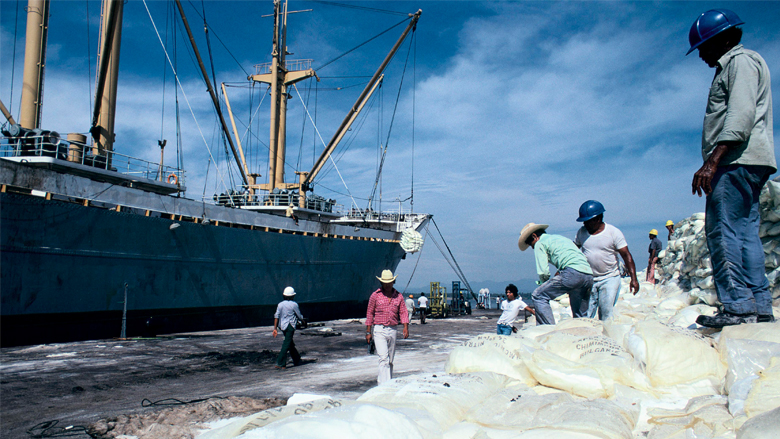Context
Using trade more effectively to expand sources of sustainable incomes is essential to achieving the World Bank Group’s Twin Goals of ending extreme poverty and boosting shared prosperity. Economic integration through trade and improved competitiveness is central to any development strategy. The challenges for developing countries are to grow their economies, improve productivity, boost real incomes and create more and better jobs. These require that countries be better integrated with the world economy and policymakers, private firms and international partners are actively seeking support from the Macroeconomics, Trade and Investment (MTI) Global Practice in finding effective ways to do this.
Strategy
The Umbrella Facility for Trade, a new Tripartite multi-donor trust fund formally launched at the World Bank Group Spring Meetings in April, 2017, is designed to ensure that the World Bank Group remains at the forefront of trade-related development by enriching its offerings through the research, lending, and investment support. The Umbrella Facility builds on the idea that countries seeking to grow, increase productivity, boost real income, and create more and better jobs must be better integrated with the world economy. The Umbrella Facility for Trade’s objective is to serve as a trusted partner for developing countries seeking to develop dynamic and resilient economies through expanded opportunities in trade. To this end, ODA-eligible countries supported by the Umbrella Facility will be more closely integrated in the global economy with increased trade. Its strategy rests on four pillars:
Pillar 1: Trade Competitiveness and Diversification - Competitiveness, through employment generation, is central to harnessing private sector growth for sustainable poverty reduction and, ultimately, wealth creation. Firms, especially small- and medium-sized ones, in all sectors serving export and domestic markets, cannot exploit opportunities if they are burdened by costs outside of their control that make them uncompetitive. Increasing the number and value of products produced, the number of markets served, and the survival rate of firms is conditional on lowering such costs. Activities in this area center on the economy-wide incentive framework created by prevailing policies and regulations, including trade policy; trade in services as a means to access international best practices and expand exports; and the design and implementation of specific actions to address market and information failures. The emphasis will remain on the creation of enabling policy environments that are conducive to the emergence of successful firms in the production of goods and services for both export and domestic markets.
Pillar 2: Trade Facilitation, Transport Logistics and Trade Finance - The objective of this pillar is to reduce the costs associated with moving goods along international supply chains, whether these are measured in terms of time, money, or reliability. Trade facilitation also lowers import costs and therefore has a direct impact on the prices paid by the poor for the goods they consume. Priorities are to enhance the performance of trade corridors used by land-linked developing countries, especially in Africa; regional trade facilitation frameworks; improve markets for logistics services; increase the efficiency of border management; and facilitate the cross-border movement of service suppliers.
Pillar 3: Support for Market Access and International Trade Cooperation - A country’s ability to use trade to advance its development objectives depends in part on the market access conditions that confront its exports and on the policies affecting imports of goods and services. The trade policies of developed countries, in particular, can have especially negative effects on developing countries. Advocacy to remove such distortions, and make international trade rules and institutions more supportive of the needs of developing countries, can have a direct impact on the poor. Examples of work in this area include: (i) analyzing the impact on developing countries of policies implemented by major countries, international trade rules and actions that would benefit economic development prospects; (ii) assisting governments to remove tariff and non-tariff barriers to regional market integration including in the context of mega-preferential trade agreements; and (iii) supporting international cooperation on trade-related regulatory reform (especially services policies).
Pillar 4: Managing Shocks and Promoting Greater Inclusion - Making gains from globalization more inclusive and beneficial to poor households while addressing the needs of the unemployed during transition periods is critical to poverty reduction. This is a cross-cutting pillar with the objective of addressing trade-related shocks and enabling greater participation of poor households in the benefits of trade. This pillar includes activities that aim to benefit the poor in multiple ways:
- Supporting informal traders in growing their businesses, lowering trade costs, and improving the conditions they face at borders;
- Addressing inequalities in the labor market – in terms of both skills and gender – that can arise when trade becomes more open and assisting the most vulnerable people manage trade shocks;
- Promoting internal trade in order to help connect remote regions to high growth areas;
Results
A results framework sets targets for results, sustainability, impact, and priority focus. Progress against the results framework will be reported annually. Key elements include:
- Focus on priority clients, specifically the share of regional project implementation spent in Sub-Saharan Africa and other IDA countries.
- Focus on global engagements (advocacy, knowledge, research, data, partnerships).
- Focus on gender inequality.
- Client satisfaction covering T&C projects.
- Value for Money in terms of leveraging IBRD lending and IFC investment operations and boosting overall T&C spending on trade using WBG-own resources.
- Number of outputs.
